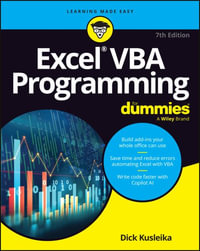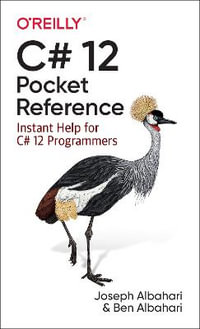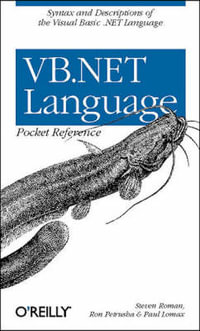| Foreword | p. xv |
| About the Author | p. xxiii |
| About the Technical Reviewer | p. xxv |
| About the Foreword Writer | p. xxvii |
| Acknowledgments | p. xxix |
| Introduction | p. xxxi |
| The Mainframe Paradigm Shift | p. 1 |
| Your Future with COBOL | p. 3 |
| Why Software Vendors Care About Mainframe COBOL | p. 4 |
| Creating a New Standard for Mainframe COBOL | p. 6 |
| Mainframe COBOL: How Will It Look? | p. 15 |
| Your Reformation Has Begun | p. 25 |
| Summary | p. 27 |
| To Learn More | p. 28 |
| What Is .NET? | p. 29 |
| Putting the .NET Question into Perspective | p. 30 |
| Programming Essentials with a .NET Language | p. 31 |
| Accessing Data the .NET Way | p. 37 |
| Interfacing with the User Using .NET | p. 40 |
| Understanding Advanced .NET Technologies | p. 46 |
| Marketing and Planning for .NET | p. 52 |
| Summary | p. 57 |
| To Learn More | p. 58 |
| .NET Retraining Prerequisites | p. 59 |
| Presenting a Historical View to Understand Our Future | p. 60 |
| Take a Reality Check | p. 65 |
| Building Blocks for Your .NET Training | p. 66 |
| Summary | p. 90 |
| To Learn More | p. 91 |
| .NET Retraining Prerequisites, Part 2 | p. 93 |
| Object-Oriented Programming | p. 94 |
| Hypertext Markup Language | p. 105 |
| Client-Side Scripting Languages | p. 110 |
| Extensible Markup Language | p. 115 |
| Summary | p. 127 |
| To Learn More | p. 127 |
| .NET Programming Essentials | p. 131 |
| Inside the .NET Integrated Development Environment | p. 133 |
| Integrated Development Environments | p. 134 |
| Choosing Your .NET Language | p. 159 |
| Developing Your First .NET Programs | p. 163 |
| Summary | p. 169 |
| To Learn More | p. 170 |
| The Nuts and Bolts of .NET Programming | p. 171 |
| Taking a New Look at Old Programming Syntax | p. 171 |
| Examining Microsoft Intermediate Language | p. 197 |
| Summary | p. 202 |
| To Learn More | p. 202 |
| The .NET Framework | p. 205 |
| Dicing the .NET Framework | p. 205 |
| (Re)using the .NET Framework | p. 228 |
| Summary | p. 242 |
| To Learn More | p. 243 |
| The .NET Common Language Runtime | p. 245 |
| Understanding the Common Language Runtime | p. 245 |
| The Garbage Collector | p. 249 |
| Summary | p. 278 |
| To Learn More | p. 278 |
| Creating and Using Objects | p. 281 |
| The Origin of "the Object" | p. 282 |
| Finally, Value versus Reference Objects | p. 288 |
| Object Visibility and Availability | p. 313 |
| Summary | p. 318 |
| To Learn More | p. 318 |
| Reading, Writing, and Describing Data | p. 321 |
| A New Perspective Toward Data | p. 323 |
| A Basic View of Data: Files | p. 324 |
| An Extended View of Data: Data Repositories | p. 342 |
| A Meta View of Data: Metadata | p. 347 |
| Summary | p. 357 |
| To Learn More | p. 357 |
| Database Programming with .NET | p. 359 |
| SQL Server 2000: A .NET Enterprise Server | p. 360 |
| Database Programming with .NET | p. 377 |
| Summary | p. 405 |
| To Learn More | p. 406 |
| XML in a Managed Environment | p. 409 |
| XML and the .NET Dataset | p. 410 |
| An XML Namespace: System.Xml | p. 434 |
| The Other XML Namespaces | p. 439 |
| Summary | p. 440 |
| To Learn More | p. 441 |
| Interfacing and Interacting with the User | p. 443 |
| Windows Forms, Web Forms, and No Forms | p. 445 |
| Developing with the User in Mind | p. 447 |
| Windows Development on .NET | p. 453 |
| ASP .NET Web Development | p. 471 |
| Summary | p. 505 |
| To Learn More | p. 505 |
| Adding Value to Your Interface | p. 509 |
| Making Your Windows Applications Informative | p. 510 |
| Making Your ASP .NET Applications Interactive | p. 528 |
| Adding Value with XML Web Services | p. 543 |
| Summary | p. 547 |
| To Learn More | p. 548 |
| Managing Cache and State for ASP .NET | p. 551 |
| Legacy CICS "State Management" | p. 552 |
| Preparation for Cache and State | p. 554 |
| Save Your Cache! | p. 556 |
| State for the Stateless Protocol | p. 562 |
| Other Types of "State Management" | p. 590 |
| User Interface for the Sample Applications | p. 592 |
| Summary | p. 593 |
| To Learn More | p. 594 |
| Reporting and Information Delivery | p. 597 |
| Using Crystal Reports for VS .NET | p. 598 |
| Electronic Report Delivery | p. 614 |
| Summary | p. 628 |
| To Learn More | p. 629 |
| Deploying Your .NET Application | p. 631 |
| Deployment Considerations | p. 632 |
| Automate with Microsoft Windows Installer 2.0 | p. 647 |
| The Manual Approach: XCOPY or Copy | p. 667 |
| Summary | p. 676 |
| To Learn More | p. 677 |
| Advanced .NET Technologies | p. 679 |
| Configuration for .NET Applications | p. 681 |
| Configuration with Directives | p. 682 |
| Configuration with Custom Attributes | p. 684 |
| Configuration with XML-Based Files | p. 706 |
| Configuration with Configuration Namespaces | p. 718 |
| Configuring for Code Access Security | p. 722 |
| Summary | p. 746 |
| To Learn More | p. 747 |
| Using Enterprise Services (COM+) | p. 749 |
| What Is COM+? | p. 750 |
| Creating a Serviced Component | p. 757 |
| Introducing Your Serviced Component to COM+ | p. 767 |
| Using Your Serviced Component | p. 790 |
| Summary | p. 797 |
| To Learn More | p. 798 |
| Developing for the Enterprise | p. 801 |
| Distributed, Asynchronous, and Concurrent Application Models | p. 803 |
| Revisiting Microsoft Message Queuing (MSMQ) | p. 805 |
| Asynchronous Processing | p. 821 |
| .NET Remoting | p. 843 |
| Introducing Multithreading | p. 847 |
| Summary | p. 877 |
| To Learn More | p. 878 |
| Appendixes | p. 883 |
| Debugging and Testing | p. 885 |
| Debugging | p. 886 |
| Testing | p. 900 |
| Summary | p. 909 |
| To Learn More | p. 910 |
| A Sharp Primer: C# and J# | p. 913 |
| Introducing Visual C# .NET | p. 913 |
| Introducing Visual J# .NET | p. 925 |
| Summary | p. 933 |
| To Learn More | p. 934 |
| Religion, Landmines, and Distractions | p. 937 |
| Distractions: Been There, Done That | p. 938 |
| Summary | p. 944 |
| To Learn More | p. 945 |
| Fujitsu's NetCOBOL for .NET | p. 947 |
| Product Features | p. 947 |
| Product Documentation | p. 949 |
| Summary | p. 950 |
| To Learn More | p. 951 |
| Index | p. 953 |
| Table of Contents provided by Rittenhouse. All Rights Reserved. |
























